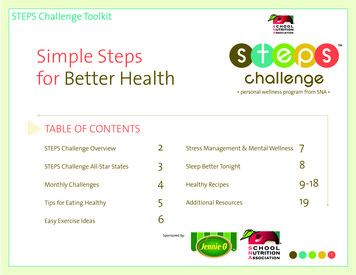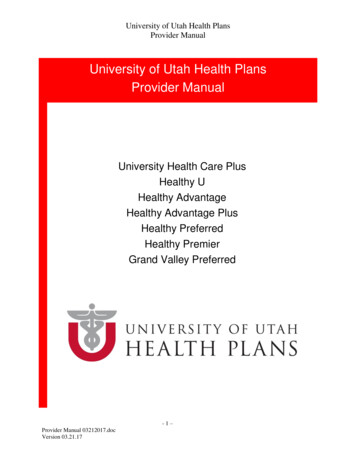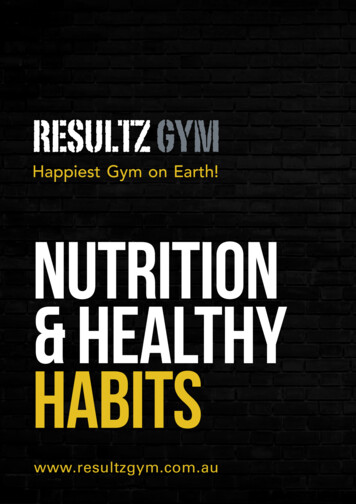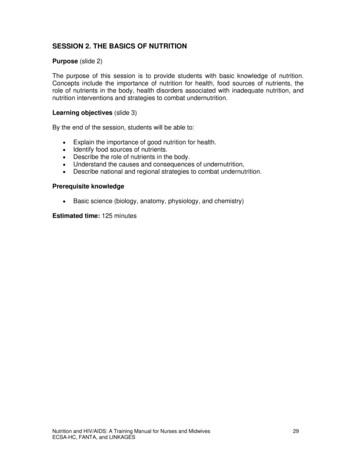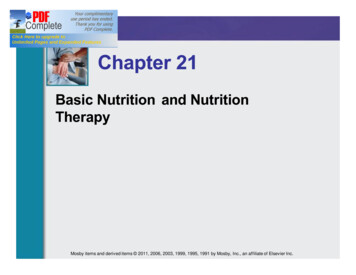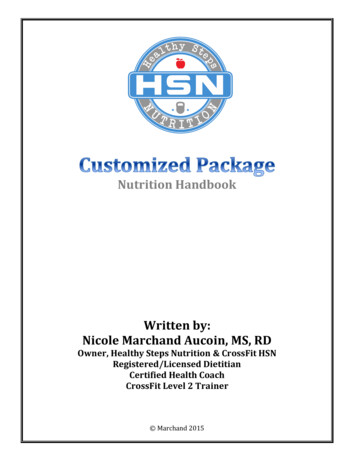
Transcription
Nutrition HandbookWritten by:Nicole Marchand Aucoin, MS, RDOwner, Healthy Steps Nutrition & CrossFit HSNRegistered/Licensed DietitianCertified Health CoachCrossFit Level 2 Trainer Marchand 2015
Contents:Chapter 1: Determine a BaselineChapter 2: Goal SettingChapter 3: Macronutrient Breakdown & The Zone DietChapter 4: HydrationChapter 5: Consistency & Staying on TrackChapter 6: SupplementationAppendix: Disease Prevention Marchand 2015
Chapter 1: Determining a BaselineBefore changing your diet, it is important to see what areas you need to work on and lookat the whole picture. While most people are concerned with their weight, a healthylifestyle affects many areas of your life such as stress management, energy levels, how youfeel, mood, disease prevention/management and many more. Here are some questions toask yourself to determine what areas you might need to work on.Where to start? How to determine your baseline? Are you eating CLEAN? C: Consistency/timing/eating around workouts What does your typical day look like? How many meals do you get in a day?Do you snack or graze throughout the day? Are you eating before and afteryou workout? L: Liquids/hydration/alcohol How much water do you drink a day? What other types of beverages doyou drink? Do you drink sugar-sweetened beverages (juice, soda, sweettea, lemonade, flavored coffees)? How much and how often do you drinkalcohol? E: Eating out How often do you eat out? Where do you usually go? What do you usuallyget? A: Adequate calories/too much or too little Do you track your food or make a food log? Have you ever used a foodtracking application (MyFitnessPal)? N: Nutritious foods/quality macronutrients over quantity How many servings of fruits and veggies do you include into your diet? Doyou include whole grains into your routine? Do you include protein andcarbohydrates with all meals? Do you shop the perimeter of the grocerystore? Marchand 2015
Chapter 2: Goal SettingYou want to set yourself up for success by setting SMART Goals! S: SpecificM: MeasureableA: AttainableR: RealisticT: Time SensitiveTips when setting your goals:1. Look at the big picture first. What are your health/ fitness/ weight/financial/education/family goals in a specific amount of time- 1, 5, 10 years downthe line?2. Set smaller goals for what you would like to accomplish 1, 2 3, 6 months. Have a to-do list Use a calendar Prioritize3. Set performance goals (ie: lifting weights, weight loss) that will motivate you.Write down WHY it is important for you.4. Always have an action plan. Write down the steps you are realistically going totake to achieve your goals.5. Stick with it! By telling your family and friends, you will have someone to stayaccountable to and keep you motivated. Marchand 2015
Questions to ask when starting to set goals: Where are you now and where do you want to go (long-term)? Then break it upinto short-term mini goals. Where do you see areas that need improvement in your health and lifestyle? For weight loss: What is your ideal weight? Remember that 1-2 pounds ofweight loss is realistic. Rapid weight loss likely means that you are losingmuscle and water weight, not fat. The weight didn’t come on in a day andtherefore won’t come off in a day. You want to get to a healthy weightcircumference ( 35 inches for ladies, 40 for guys) and an ideal body fatpercentage for your age.Goal:Steps to Achieve Goal:1.2.3.Goal:Steps to Achieve Goal:1.2.3. Marchand 2015
Chapter 3: Macronutrient Breakdown &The Zone DietMacronutrient Breakdown1. Carbohydrates are our body’s main source of fuel; spares protein from being usedas energy and aids with the oxidation (breakdown) of fat. Carbohydrates shouldcomprise about 40% of our diet. Fiber is a non-digestible carbohydrate, delays glucose absorption, helps youstay full, decreases cholesterol levels, and aides with reducing triglyceridelevels. Fiber is found in fruits, veggies and whole grains. Glycemic index (GI) tells us how fast our blood sugar will rise after eating afood (stick with low glycemic foods index foods). GI indicates how much of aninsulin response our body will have to produce to breakdown what we justate. Remember, insulin response is an inflammatory response. After youexercise is the best time to have any higher glycemic foods. Try to avoid the excess use of artificial sweeteners. Studies show an increase inweight gain, body fat, and calorie/carbohydrate intake with high levels ofartificial sweeteners. They also cause increased “sugar cravings.” Stevia is amore natural form of a non-calorie sweetener and is made from a plant. What about the different types of sugar? Agave, honey, raw sugar, sugar cane,dextrose, maltose . Sugar is sugar in our body and it all goes through ourlymphatic system and is an inflammatory response. If we don’t burn it off, itturns into FAT! Sources: starches (bread, pasta, rice, quinoa, beans, oatmeal, steel cut oats),starchy veggies (potatoes, butternut squash, sweet potato, peas, corn), fruit,juices, dairy Marchand 2015
2. Protein is made from amino acids that provides our body’s structure, regulatesbody function, components of enzymes, immune system health, and aids hormoneregulation. Protein should comprise about 30% of our diet. Essential amino acids can’t be synthesized by the body therefore we need toobtain these proteins from food sources (eggs contains all essential aminoacids). Complementary proteins are two or more foods that when are eatentogether they provide all essential amino acids (ie: legumes & rice,mushrooms & broccoli).o Of the essential amino acids, a few are very important in terms ofrecovery after workouts: leucine, valine, isoleucine (and glutamine).During exercise, levels of these branched chain amino acids (BCAAs)decrease which leads to weariness and fatigue. This is one of thereasons that a post recovery shake will contain extra BCAAs to help withrecovery and muscle rebuilding after workouts. Conditionally essential amino acids are amino acids that our body canmake the precursors but under some conditions we can’t make enough (ie:glutamine and arginine during stress). Sources:o Lean Meats: fish, chicken breast, pork loin, legumes, cottage cheese,triple zero greek yogurt (carb and protein), turkeyo Medium Fat Meats (1 Protein 1 Fat): cheese (cottage and gratedparm) chicken (dark meat no skin)o High Fat Meats (1 Protein 2 Fats): full-fat dairy, red meats, bacon,most cheese, pork, ribs, eggs Marchand 2015
3. Fat is a component of our membranes particularly in the brain and nervous system,aides in the absorption of fat-soluble vitamins and is used as a source of energy. WENEED FAT. Healthy sources of fat should comprise of about 30% of our diet. Stay away from saturated and trans fats (increase your LDL/badcholesterol, trans fats also decrease HDL/good cholesterol) Increase Omega 3 intake (sources: salmon, herring, canola oil,olive oil, flaxseeds, chia seeds, some eggs are fortified,supplements). Omega 3 supplements are recommended to ensurethat you are consuming adequate amounts of DHA and EPA. Cholesterol is a component of cell membranes, needed forhormone production, our body makes cholesterol, and it is found inanimal products (egg yolk, organ meats, fish roe). Sources: fats, meats, dairy, nuts/ nut butters, avocado, olives,butter, cream, coconut milkThe Plate Method & Eating Out: This is one of the simplest methods looking to changeyour diet and eat quality foods. ½ of the plate Non-starchy Veggies¼ of the plate Lean Meats¼ of the plate Complex Carbohydrates Marchand 2015
The Zone DietThe Zone Diet recommends a balance of hormones to optimize the breakdown ofmacronutrients. These hormones include insulin, glucagon and eicosanoids. The dietrecommends a balance of 40% of calories coming from carbohydrate, 30% caloriesfrom protein and 30% from fat. The Zone diet also takes into account glycemic indexmeaning how much insulin in your pancreas is needed in order to breakdown thecarbohydrates that you ate. Low glycemic foods include foods that are low in sugar andare typically high in fiber. This diet also promotes incorporating healthy sources ofunsaturated fats (nuts, seeds and healthy oils).The Zone diet breaks food up into “blocks” to determine the appropriate ratio ofprotein to carbohydrates. The amount of blocks that a person needs is individualizedand is based on gender, lean muscle mass, activity factor and goals (weight loss vsweight gain).Where Are You?General Guidelines for Females and Zone blocks:BSLSDTotalBlocksTotal CaloriesGrams P/C/F4WeightP/C/FLossMaintenance 41P/C/ F4P/C/F1P/C/F4P/C/F15 P/C/F1365calories105 P/ 135 C/ 52 F1 P/C/F5P/C/F1P/C/F5 P/C5F18 P/C/F1638 calories126 P/ 162 C/ 54 FPerformance 4 P/C1 P/C2F5 P/C6F2 P/C2F5 P/C6F20 P/C20-25 F 1820 calories140 P/180 C/60 FDTotalBlocksTotal Calories& Grams P/C/FP/C/F6FGeneral Guidelines for Males and Zone blocks:BSLS4WeightP/C/FLossMaintenance 5 P/C1P/C/F5P/C/F1P/C/F5P/C/ F18 P/C/ F1638 calories126 P/ 162 C/ 54F2 P/C4F6 P/C6F2 P/C4F5 P/C5F20 P/C/F1820 calories140 P/ 180 C/ 60 FPerformance 6 P/C3 P/C3F6 P/C6F3 P/C3F6 P/C8F24 P/C28 F 2292 calories168 P/216 C/84 F10 F8F Marchand 2015
What is ONE SERVING?Activity:1. Highlight the foods that you like and would eat2. Make a sample day with Your Ideal Blocks using the Sample Meal PlanSheet!Protein Serving SizeBreakfast:Egg 1 FatEgg 2 FatsEgg whitesEgg substituteBacon 2 FatTurkey baconSausage 2 fatTurkey Sausage 1 FatCanadian baconHamCheeseLunch & Dinner:1 large1 jumbo2 large¼c2 slices2 slices1 ounce1 ounce1 slice1 ounce1 ounceChickenTurkey BreastGround TurkeyVealGround beef (93%) 1FatFiletPrime Rib 2 FatDuckLambPork TenderloinPork 2 FatShrimpCalamariSalmonCanned TunaWhite fishProtein powderSoy burgerCheddar cheese 3 FatsSoft tofu 1 FatFirm tofu 1 Fat Marchand 20151 ounce1 ounce1.5 ounces1 ounce1 ounce1 ounce1 ounce1 ounce1 ounce1 ounce1 ounce3 large1.5 ounces1.5 ounces1 ounce1.5 ounces1 ounce½ patty1 ounce3 ounces2 ounces
Carbohydrate Serving SizeBreakfast:OatmealSteel Cut OatsGreek yogurt 1 arineOrangePearPineapplePlumTangerineEzekiel breadSprouted wrapLunch & Dinner:1/3 cup1/3 cup½ cup½1/3½ cup1 cup½ cup½ cup½ oz.½2/3 cup11½½½½ cup11¾ slice½Condiments (LIMIT):BBQ SauceCatsupPickleTeriyaki SauceJelly2 Tablespoons2 Tablespoons6 slices1.5 tablespoons2 teaspoonsBarley (not cooked)Buckwheat (dry/notcooked)Brown riceQuinoaButternut squashAsparagusBlack een BeansKaleLentilsMushroomsOnionOnionSpaghetti squashSpinachTomato SauceTomato (Cherry)ZucchiniSquashSweet potatoModeration***Rice cakeBaked PotatoBuckwheatBulgurEzekiel BreadGranolaPopcorn8-inch flour tortilla Marchand 2015½ tsp½ oz1/5 cup1/5 cup½ cup cooked12 slices¼ cup1.25 cup (Cooked)1 cup1.25 cup (Cooked)¼ cup1.25 cup1.25 cups2 cups¼ cup2 cups½ cup (Cooked)1.5 cups (Raw)1 cup2 cups½ cup2 cups1.25 cups1.25 cups1/3 cup1¼ cup½ ounce½ ounce½ ounce2 cups½
Fat Serving SizeAlmondsAvocado & GuacamoleOlive (green)Peanut/almond butterPeanutsCashewCoconut oilGuacamoleOilMayoSunflower seedsButter½ and ½Light creamTarter sauceWalnutsPecans6 or 1 Tablespoon1.5 Tablespoon51 tsp66½ tsp1 Tablespoon½ tsp½ tsp¼ tsp¾ tsp2 tablespoon1 tablespoon1.5 tablespoons½ tablespoon3 Marchand 2015
Chapter 4: Hydration Role of water in the body: Water is needed for all metabolism processes.Water keeps your cells alive (transports nutrients to the cells on a molecularlevel), regulates body temperature, removes waste products (especiallybyproducts of fat breakdown) and acts as a lubricant around your joints, brainand spinal cord. Tips to drink more water: Carry a water bottle with you, bring one in thecar, drink at least a cup in the morning before leaving the house, get a big jugand write times on it, refill every time you go to the bathroom or setreminders on your phone. Switch up the taste by adding mint, cucumber,strawberries, lemons or oranges. Juice and juicing: Juicing has become extremely popular over the years.While juicing can be healthy, the issue arises when you are juicing with anapple, banana, orange, and kiwi. What’s wrong with this picture? The grams ofsugar add up quickly when juicing and some of the important properties offruit (such as fiber) are lost in the juicing process. Tips: When making a juice,use 75% veggies and no more than 25% fruit. Use a nutribullet instead of thetypical juicing machines. Alcohol: How much and what are you drinking? One glass of wine isn’t goingto make or break you. Can I save up all seven drinks for one night? NO! Manyof the alcoholic drinks are LOADED with sugar. Depends on what your goalsare? What about another form of stress relief? Try to turn to exercise, yoga oranother form of stress relief instead of alcohol.What tips will you use to drink more water?Notes: Marchand 2015
Chapter 5: Consistency & Staying on TrackConsistency Timing: Eating every 3 hours will help your metabolic rate, prevent you fromindulging and overeating later throughout the day. Your body can only absorbso much at one time, for instance about 40 grams of protein at a sitting (henceno more than 6 blocks of protein per meal). By eating smaller mealsthroughout the day, it will prevent over eating and keep you satisfied. Eating around your workouts: Have a source of carbohydrates and proteinbefore your workout. If you workout early in the morning try liquids beforethe workout (shake/smoothie). Higher glycemic foods are preferred aroundyour workout time to replace glycogen stores but not just sugar! Eat withinthe window (30 minutes for carbohydrates, 45-60 minutes protein). Liquidprotein after your workout is best (ie: recovery protein shake with almondmilk). Why eat after you workout?1. Replace muscle glycogen stores (your carbohydrate stores inyour body). Higher glycemic load carbohydrates for quickreplacement and lower glycemic load carbohydrates for a slowrelease of sugar into the blood.2. Rehydrate with water!3. Replenish amino acids for rebuilding muscle which was brokendown during your workout. Primarily sources of branch chainamino acids (isoleucine, valine and leucine). Egg white proteinand whey protein are great source of BCAAs.4. Replace electrolytes (sodium, chloride, potassium, calcium andmagnesium). Protein and carbohydrate pairing: You want to pair PRO and CHO togetherto help with absorption, metabolism, to maintain optimal hormone balanceand to keep you full longer! 1:1 Ratio of Protein:Carbohydrate blocks then addin the healthy sources of fat with a 1:1-1:2 ratio. Marchand 2015
Meal Prep: Taking a few hours on the weekend will help you stay on track!This is the single most important trick to staying on track. Take a couple hourson the weekend to plan your food for the week, shop and prep the meals. Thecrockpot is a great resource for healthy, delicious and convenient meals!Going a step further to portion the foods into containers will seal the deal. Find healthy recipes or alter your favorites to make them healthier. Look onour website, www.myhealthysteps-nutrition.com for easy healthy recipes! Cheat Meals: The simple answer is that it depends on what your goals are.The stricter you are with following a healthy meal plan, the better your resultswill be. Once you are on a “maintenance plan” you are welcome to have theoccasional treat. Some clients do well on the weekdays and everything goesdown the drain on the weekends. This popular approach counteractseverything that you work so hard for during the week. I would recommendsteering away from the famous “cheat meal/meals” because it makes you feellike you are doing something wrong. When I think of cheat meal, I think of anentire pizza then an extra large blizzard. What’s wrong with this picture? It’sok to have a TREAT once in a while but don’t overindulge. Eating out Look at the Menu Before Hand: Most restaurants post their menunutrition facts online and many places actually have the calories or a“skinny” section on their menus as well. Pick 3 things that look good to you: From there- make your decisionbased on how you can modify the item and which would fit best into themeal plan (sauces on the side, grilled or baked, lean means, be careful withthe starches and added fats), specialty salads aren’t necessarily the bestway to go (ie: Quesadilla Explosion salad – 1200 calories) Ask for a salad and SKIP THE BREAD: Start with non-starchy veggies tohelp curb your appetite and act as a “filler”, dressing on the side, ask for alight balsamic dressing (fork dipping trick), be careful with the added fatfrom source such as croutons and cheese. Marchand 2015
Beware of portion sizes: Remember 3-4 ounces of meat at a time, you aregiven at least double that in the restaurants, put half in a to-go box, sharewith a friend, get the lunch portion, or order off the appetizer menu. Make your Modifications: Be specific about what you want, ask questionsabout how the food is prepared (baked, boiled or grilled), sauces on theside, watch out for the adjectives- hearty, lemon-butter sauce, loaded. Other tips: be mindful, savor the food and chew slowly, drink WATER,don’t forget that you CAN TAKE SOME HOME!Staying on Track Accountability: Find a good accountability partner to help keep you focused.Tell your close friends and family your goals so that if they see you slackingthey can be that ear of encouragement and accountability. Reward yourself when you achieve your short-term goals. Don’t wait till you’ve reached your long-term goal. Keep yourselfencouraged and motivated by rewarding yourself along the way.Otherwise, you may get discouraged and stop moving forward. Find little rewards that you can look forward to- What is a special littletreat that will keep you motivated? NO FOOD. Get out of you comfort zone and try something new! Find an outfit or bathing suit that you want to fit in to and hang it up whereyou can see it! Find a work-out partner: Try and find someone that is strong in the areas where you are weak sothat you can push each other to the next level. For example, if you are inconsistent with your work-outs, find a partnerthat is very consistent. If you do not like working out a certain musclegroup, look for a partner who loves to work-out that muscle group. Marchand 2015
Food Logging: You will have better results if you track your food! There aremany different apps that track food but MyFitnessPal is one of my favorites.Make sure that you not only write the food but also the portion size and howyou feel after. This is a great way to trigger what foods you don’t tolerate welland what causes you to be tired, bloated or gassy. Tracking Progress (Measurements/Body Fat/Annual Health Screening/LabWork): It is a good idea to redo your measurements every 3 weeks to ensureyou are on the right track and seeing the changes that you are looking for! Ask us how we can help with our On-Going Coaching Program!Notes: Marchand 2015
Chapter 6: Supplementation & Disease PreventionSupplements Goals: What would you like to achieve? What risk factors are in your family? Whole food over supplements is best due to bioavailability andabsorption rates. Taking many different vitamins and minerals in thepill form is not recommended. Supplements are recommended when your intake isn’t enough to coveryour needs. Lab work: If your lab work shows you are low in something, this would be agood reason to take the supplement. Health screenings and annual check upsare recommended. HDL is your good cholesterol, which often is somethingthat is commonly low. Pre/Post workout and muscle recovery: Protein after workouts is highlyrecommended. Liquid should be recommended because it is quickly absorbed.Recommended time frame: 30 minutes for carbohydrates and within 45-60minutes for protein to promote replacing your glycogen stores and musclerebuilding. Studies show whey protein is the most beneficial with buildinglean muscle mass post workout. Gas and bloating can be from the artificialingredients/sweeteners. SFH is a grass fed whey protein which no artificialingredients and is sweetened with stevia. Omegas: Omega 3 fatty acids play an important roll in the body by decreasinginflammation, decreasing recovery time, improved heart health and mood.Omega 6s and 9s increase inflammation and increase your body’s reaction tostress. Although we need some of the omega 6s and 9s, we don’t want to addadditional sources through supplementation. When taking an omegasupplement, you only want to take omega 3s (look for the scientific term isDHA or EPA on the label). Most supplements contain small amounts of omega3s and are mostly comprised of omega 6s and 9s. You might find a fish oilsupplement that claims to have “1000mg” but when you look at the back it isonly 240mg of the good stuff (DHA/EPA). Pure Pharma and SFH carry greatlines Omega 3 supplements. Marchand 2015
Vitamins: Vitamin supplements contain binders and fillers that are hard foryour stomach to break down. Recommend a diet full of colorful fruits andveggies to ensure you are getting adequate amounts of vitamins and minerals. Vitamin D: Plays many important roles in the body such as promotingcalcium absorption, immune function, reduction of inflammation andcell growth. An estimated 75% of Americans are Vitamin Ddeficient, which is why vitamin D supplement would be a good idea.Vitamin D deficiencies have been linked to cardiovascular disease,cancer and severe asthma in children. Vitamin D has been linked to theprevention of diabetes, hypertension glucose intolerance and MS. Zinc: Plays a role with many different biochemical processes such ascellular respiration, DNA reproduction, maintenance of cell membraneintegrity and powerful antioxidant/free radical scavenging. More than300 enzymes activity requires zinc. Zinc plays a major role in proteinsynthesis and optimal athletic performance. Zinc deficiencies candecrease performance as well as affect delayed fatigue, decreased mood,immunity and low energy. Good sources of zinc are cod (97% RDA),kidney beans (29% RDA) and turkey (23% RDA). Magnesium: Plays a vital role in the metabolism in our body in the formof ATP production (our body’s energy currency). Magnesium and Zincare important for athletes because they help with muscle contraction,oxygen delivery to working muscles and sustaining athleticperformance. Benefits of Magnesium: better sleep, increase musclebuilding, protein synthesis, mood/decreased depression, improvedinsulin sensitivity, stress control and metabolism of cortisol. Magnesiumdeficiencies have been linked to altered cardiovascular function,impaired carbohydrate metabolism/insulin resistance, decreasedinsulin secretion and high blood pressure. Joint health: Glucosamine has been shown to help with lubricating the joints.Recommend liquid over pill form. Marchand 2015
Appendix:Disease Prevention Prevalence of preventable disease According to the CDC, more than one third of US adults are consideredobese Obesity related conditions such as stroke, cardiovascular disease, type 2diabetes and some cancers are some of the leading causes ofpreventable death Over 147 billion dollars are spent on obesity related conditionsannually in the US Childhood obesity has more than doubled in children and quadrupled inadolescents over the past 30 years Healthy eating and lifestyle changes are for the WHOLE family. Everyone needsto be on board. It’s never too early to get children thinking about nutrition andmaking good food choices. Genetics vs environment: Studies have shown that the primarydeterminants of most cancers are lifestyle factors, such as tobacco, dietary andexercise habits, environment carcinogens and infectious agents, rather thaninherited genetic factors. Marchand 2015
Health Indicators & Understanding Your NumbersBMI:Your BMI:UnderweightNormal 18.518.5-24.99Overweight25-29.99Obese Grade I30-34.99Obese Grade II ( ) 35.00Tips: Little changes in weight make big changes in BMI, this isn’t the best indicator ofhealth status because it doesn’t take into account muscle mass, remember to look atthe whole picture (measurements and body fat percentage)Body Fat Percentage:WomenMenEssential -5923-33%11-21%60-7924-35%12-24%Your Body Fat%Tips: Balanced diet (mostly non-starchy veggies, lean meats, some fruits , healthy fatsand some low glycemic carbohydrates, strength training is KEY! Marchand 2015
Waist Circumference:WomenMenLow Risk 35 inches 40 inchesHigh Risk 35 inches 40 inchesYour Waist Circumference:Tips: Balance diet, Consistency, Try cutting out dairy to help with bloating, check for foodintolerances? Elimination diet with a food log to see if you are having consistent bloatingafter certain foods, strength training Remember: ABS are made in the Kitchen!Blood Pressure:SystolicDiastolicNormal 120 80Pre-Hypertension120-12980-89Stage I Hypertension140-15990-99Stage II Hypertension160 100 Your BP:Tips: Low sodium diet, limit caffeine and processed foods, exercise (your heart is a muscle,you need to strengthen that muscle with cardiovascular exercise)Blood Glucose:FastingNon-fastingLow 70 70Normal70-9970-140High 126 141Your Blood Glucose:Tips: Consistent carbohydrate intake, stick to low glycemic carbohydrates, no morethan 60 grams of carbs per sitting, cut out the processed and refined sugars/grains,pair protein with every meal, increase water intake, exercise Marchand 2015
Total Cholesterol:Your Cholesterol:Desirable 200 mg/dLBorderline200-239 mg/dLHigh 240 mg/dLTips: Cut down on the high fat animal products (saturated fats), increase fiber intake,take your omega 3s, no smoking, exerciseHDL “Good” Cholesterol:WomenMenYour HDL:Low 50 mg/dL 40 mg/dLAverage50-59 mg/dL40-59 mg/dLGreat! 60 mg/dL 60 mg/dLTips: Increase your omega 3s (salmon, almonds, pecans, walnuts, mackerel, herring,chia seeds), pure omega 3 supplements, eliminate trans fatsTC/HDL Ratio:Your Ratio:Low Risk 3.6Average Risk3.6-4.9High Risk 4.9Tips: Lower total cholesterol, increase HDL by incorporating omega 3s and exercise Marchand 2015
Sources:Cordain, Loren. The Paleo Diet for Athletes. New York: Rodale. 2012.Hess, Mary. Review of Dietetics. Chicago: Hess & Hunt. 2012.Micheletti, A, Rossi, R. Zinc status in athletes: relation to diet andexercise. Sports Med. 2001;31(8):577-82.Nelms, M, Sucher, K, Lacey, K. Nutrition Therapy & Pathophysiology.Wadsworth: Cengage Learning. 2011.Sears, Barry. The Anti-Inflammation Zone. New York: HarperCollinsPublishers, Inc. 2006.Sears, Barry. Enter The Zone. New York: HarperCollins Publishers, Inc. 1995.****Disclaimer: If any of these numbers are elevated, it is highlyrecommended you follow-up with your physician and have medicalclearance. Your meal plan is designed to optimize all these numbersbut shouldn’t replace any medications prescribed to you by yourdoctor. ***** Marchand 2015
Marchand 2015 Nutrition Handbook Written by: Nicole Marchand Aucoin, MS, RD Owner, Healthy Steps Nutrition &

